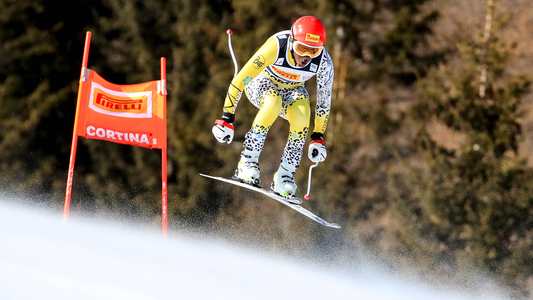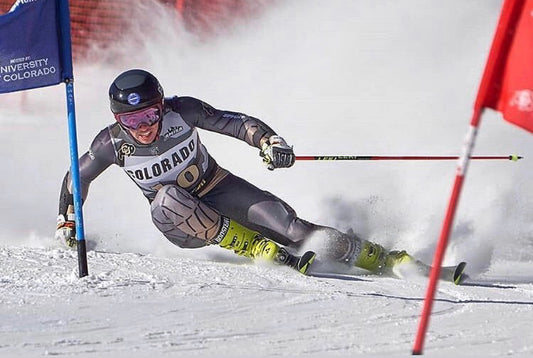The temperature hovers around 7° Fahrenheit, a strip of vibrant oranges, yellows, and pinks paints the sky to the East, and the snow is skiing ideally for the University of Colorado Ski Team at Eldora Mountain Resort. It’s 6:45 a.m. and this group of college students are up more than two hours before you might start to find the majority of their peers emerging from their houses down the canyon road in Boulder, Colo. One face appears to be especially focused this frigid morning, and that is Spyder collegiate Athlete Bobby Ryan in between training runs as the CU Ski Team prepares for their next race of the NCAA Ski Season. It is obvious that the life of NCAA ski racers differs significantly from that of the average college student. We caught up with Bobby recently to get a peek into how the season has unfolded to the halfway point in the season for the New York native and learned more about the psychological tweaks that go into racing success that turn out to be just as difficult as making turns on an icy ski run faster than the rest of an elite field.
Bobby shares with us that the collegiate race season is even more complex than most folks realize. In addition to skiing in the NCAA competitions against other top universities including University of Utah, Montana State University, University of Denver, and more, these student-athletes compete on the FIS North American race circuit (NorAm) against some of the world’s top skiers–all of whom are vying for sports in FIS World Cup races. NorAm races are precisely where the season began.
The season began at the US Ski Team training grounds of Copper Mountain, Colo. for a NorAm race, before continuing to Panorama, British Columbia in the midst of CU’s first semester final exams. “We’d be up early inspecting the course, then racing, and in the afternoon and evening we’d be in the hotel studying for finals or taking them”, Bobby shared. Nonetheless, after straddling a gate and skiing off the course at Copper, Bobby picked up his first NorAm points at Panorama, before moving swiftly on to a Winter Classic series in Steamboat, Colo., a brief intermission for the holidays, and subsequently straight into the first two official NCAA races in Park City, Utah and Bozeman, Montana. If that sounds like the team has been on the road all Winter, well, it’s largely because they have, while balancing the demands of school the entire time.
Now, as a small break comes before the remainder of the NCAA regular season, regionals, and the National Championship, Bobby has been evaluating what he can change to translate what he describes as “my best skiing” in chilly practices at Eldora to races. The answer, it seems, lies not in adjusting his skiing technique, but rather his mental approach before races. “Everybody knows exactly what they need to do… some people are just better on the mental side of racing than others. And that’s something I wasn’t really willing to admit to myself until recently”, shared Bobby; unafraid of vulnerability. “How do I get better at that is something that I’ve wrestled with in this brief downtime”, says Bobby. Specifically, locking into the kind of “flow state”–in which athletes often do their best skiing–is an aspect he’s currently exploring.
Asked how straddling a gate might tempt him to ski more conservatively in order to score points, the answer is: it doesn’t. Despite skiing out of the course in a couple races this year, Bobby is more interested in continuing to take risks each race in pursuit of a win than “leaving any speed on the mountain whatsoever.” As such, Bobby has become a student of the psychology of ski racing in recent weeks as he considers what strategies might help him to succeed, he has embraced a willingness to try new things at the top of the start gate in order to better lock in for success, we were surprised to hear what his answer to this ongoing question is, for now at least. “I think for me, the biggest thing is focusing on gratitude–how much fun I’m having, how crazy my life is that I get to go to all these ski resorts around the world, and getting to ski with my teammates who become my best friends and letting go of some of the self-imposed expectations”, Bobby says. We are struck by these sage words that are wise beyond the years of any typical college student. “As soon as I started talking about [the mental side of things] and opening up about it, and then being able to talk candidly with others about their approach made a huge difference”, he continues, “and up until recently I was in denial that the mental side of things might be holding me back.”
Some say that when sport–or anything for that matter–is played at an elite level, wins are decided on the margins. This couldn’t be truer in ski racing, where a singular second is considered to be a massive differential. To turn to the tweaking the psychological approach to a race, rather than to their form on their turns, is an unconventional, yet incredibly insightful approach to changing the outcome of his next race. Some of the most successful athletes in the world, including former NFL quarterback Tom Brady, NBA greats such as Kobe Bryant and Michael Jordan, or golfer Tiger Woods have all referenced how their psychological approaches to success and skills they honed to develop a mental edge on their peers contributed significantly to their greatness.
Bobby, as a student, athlete, and student of the game in skiing follows suit of such professional greats. Our bet is that this surprisingly mature approach to success from an undergraduate college student will pay dividends for Bobby as the crux of the ski season approaches in the coming weeks. Stay tuned to see how it pans out for him, and how the most successful collegiate ski program in NCAA history fares later this winter.
KEEP UP WITH BOBBY AND THE CU TEAM BY FOLLOWING @BOBBYRYAN AND @CUBUFFSSKIING


